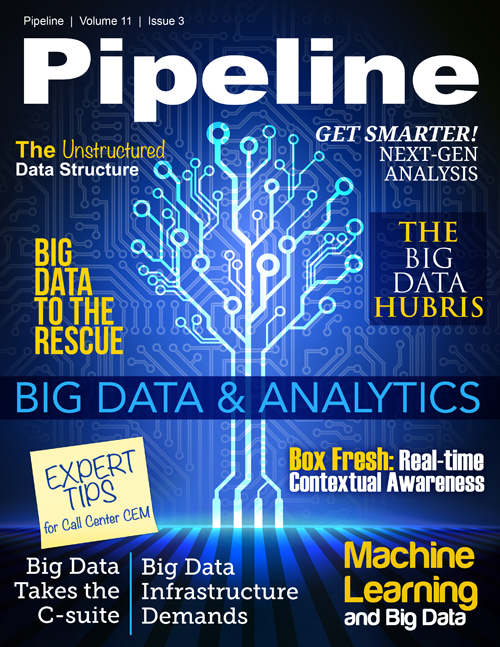Big Data Takes the C-suite
By: Nancee Ruzicka

The C-suite wants answers. In the C-suite it’s all about performance, problem solving, and progress. Understanding performance requires metrics, solving problems requires context and analysis, and moving forward requires good decisions based on comprehensive and reliable information gleaned from across the business. But there’s a reason it’s called Big Data and managing the volume and complexity of available data against resources, desired results, and staff presents executives with significant challenges.
The number of transactions occurring across wireless and wireline networks continues to increase at a steady 20-25 percent per year with no sign of slowing down. According to the Cisco 2013 Visual Networking Index, Mobile Internet and data traffic is expected to expand by greater than 60 percent through 2017 and mobile video by a staggering 90 percent during the same time period! Service providers recognize the need to process all of these transactions to ensure proper billing and settlements while preventing fraud. But these network transactions also include a wealth of detail about customer behavior, usage, location and services that operators want to take advantage of for customer care, product development, marketing, and revenue generation.
About DigitalRoute
DigitalRoute revolutionizes Network-IT integration. Its MediationZone platform:
• Improves Time-to-Market for new services.
• Enables cost efficiencies in the BSS/OSS stack.
• Facilitates data monetisation.
• Increases customer satisfaction.
We have been delivering new approaches to enterprise data management for since 1999. MediationZone offers high throughput and a unique degree of user configurability, processing all
usage and statistical data from any network -- both billable and non-billable events. The platform makes data available to the right downstream systems in the right formats in the
most appropriate volumes at the required times, without losing a single bit. It is the foundation from which multiple use-cases can be addressed in the areas of Online Control and
Data Processing.
Over 300 leading companies worldwide use DigitalRoute technology for data management including a number of OEM partners who use our platform as a central part of their own offerings.
DigitalRoute is built on the core values of Expertise, Open- Mindedness and Commitment. DigitalRoute is a venture-backed, privately held company with a turnover of 30m EUR in 2013 and
a record of profitability since 2005. With close to 200 employees, the company is headquartered in Stockholm, Sweden with regional offices in Gothenburg, Atlanta, and Kuala Lumpur.
The volume of customer transactions continues to grow exponentially and service providers face a host of new operational complexities. In addition to millions of customers and billions of transactions, operators must also capture, correlate and distribute data from millions of new devices, thousands of applications, numerous content partners and converged services offered to both retail and business customers.
To accomplish this, IT assets and applications have become increasingly distributed, virtualized, outsourced, and cloud-based. As a result, the ability to gather the right data from all the necessary sources becomes difficult; and no matter how powerful the analytics, the wrong data produces unreliable results.
With the fate of the company on their shoulders, C-suite execs aren’t taking any chances – they’re taking control. Rather than making big data and analytics an IT initiative, executives are insisting on efforts that turn big data and analytics into business improvement.
Searching for Answers
In the LavaStorm 2014 Analytics Trends Survey, more than 20% of respondents indicated that turning analytic insights into action is their biggest challenge while 16% said that gleaning insight from available data was a major difficulty and nearly 14% indicate that building trust in the insights is the biggest hurdle. Data scientists whole-heartedly agree that those are the most serious challenges and that the solution lies in the C-suite.
Metrics matter; but which ones? Rather than relying on IT to search and select what data is analyzed and how often, C-suite executives are determining the types of metrics that are important for both strategic and tactical business needs. It’s no longer about whether analytics can be directed to analyze a set of data points, but what the analysis means to the business and how the business can convert that insight into action. That requires IT to engage with the business at every level and jointly develop complex models to ask complex questions and reach business-driven results.
Dashboards and performance portals tell part of the story, but where’s the insight? Where’s the correlation? Where’s the actionable insight? There are thousands of processes that require tracking and millions of possible performance metrics that could be calculated. So which are most beneficial to the business?
What the C-Suite is Doing
Because the volume and complexity of data currently available to enterprise executives, not to mention the variety of sources, exceeds humans’ capacity to correlate and analyze, the need for big data and analytics is obvious. What is less obvious is what we’re looking for. The challenges surrounding big data and analytics are many; but, for executives, the most overlooked issue is people. The technology that can search and sort through massive amounts of data is evolving, but the supporting cast is less capable than it needs to be. None of the information means anything if the staff isn’t available.




















